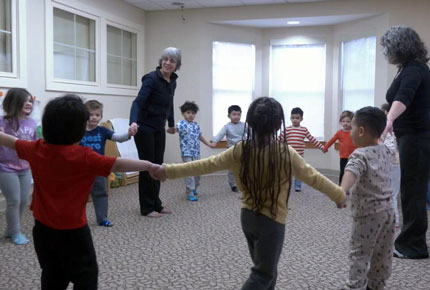Creative Movement in Early Childhood Settings
Stephanie Cardwell: Creative movement, which is also known as creative dance, is the exploration of the elements of dance through structured improvisation. Creative dance is accessible to everyone. There is no right or wrong way. It's all about exploring and discovering through improv, which is just particularly great for children.
Stephanie: Dance everything around!
Benefits of Creative Movement for Young Children (0:30)
Stephanie Cardwell: There are so many benefits to children of all ages from participating in creative dance. Overall physical development: it supports muscle development, balance, control, coordination and, a big one, which is proprioception, which is your ability to sense your own movement and location in space.
Stephanie: Imagine that you have eyes on the back of your head, so that you’re sensing, “Is there a person near me?”
Stephanie Cardwell: We have the ability to develop self-control and regulation of the body. If children are learning about the difference between general space—moving through the entire space—or staying in their self-space, you could see how that would contribute to body awareness. If we are learning the difference between stopping and starting, say, in a simple freeze dance—again, learning about body awareness.
Stephanie: Shh, shh. Let me see your frozen shape.
Stephanie Cardwell: We're learning about how much energy is in a movement and controlling that. “Am I stomping, or am I tiptoeing?” Again, this is something that is so important for impulse control, and to help them regulate their bodies and control themselves.
Stephanie: Happy, happy, happy, happy, yes! That is so happy!
Stephanie Cardwell: For self-control and regulation of emotions, the benefit is from being able to learn about feelings and express them through movement.
Stephanie: And now angry. Angry. Show me angry.
Child: Dah, dah, dah, dah…
Stephanie: Yes! Very nice.
Stephanie Cardwell: And then the final benefit that I think is worth really noting: self-esteem and self-confidence are increased by participating in creative dance. Children really blossom when they are given the opportunity to explore and discover for themselves when they can do that through a play approach, a discovery approach—not a right-way or wrong-way approach.
Stephanie: Oh, nice ending shape, Paityn!
Teacher: Awesome!
Planning a Creative Movement Lesson (2:40)
Stephanie: And let’s try dancing at high level this time.
Stephanie Cardwell: There are four primary elements that we explore, and those are space, time, body, and force. In really any lesson that I'm planning for creative dance, what I'm setting out to do is choose an element, and then choose a concept to utilize as the tool through which they can explore the element.
Stephanie: Kyle, can you show me a sharp shape with your body? And I’m going to make a smooth shape with you.
Stephanie Cardwell: So in the sharp and smooth lessons, it was the element of force. So, in that case, it was the difference between sharp movement and smooth movement.
Stephanie: Very sharp! And this is going to be my smooth shape around Kyle’s sharp shape.
Stephanie Cardwell: The idea is to take this prior knowledge that they most likely have of the words sharp, maybe even the word smooth, and then bring those ideas to a totally different context of movement, which probably they haven’t experienced, and allow them to explore, “What does that mean? What does that mean to move sharply?”
Stephanie: Sharp, sharp, sharp, sharp, sharp.
Stephanie Cardwell: This is fun to try to figure it out. The kids love to move sharply. It’s energetic. It’s performative; it’s exciting; it’s dynamic. They get to feel what that feels like in their muscles and in their body, how their balance is affected by that. Same for smooth. “What do I need to do to control my body to move without stops and starts?” Which is how I describe to young children what smooth means.
Stephanie: There’s the smooth again. Oh, it’s so calm, so peaceful.
Stephanie Cardwell: And this is a challenge for them. So yeah, it is a movement activity, but it has lots of implications for the brain.
Debriefing a Creative Movement Session (4:58)
Stephanie: Let’s think about what we just did.
Stephanie Cardwell: I love the debrief. It is just an opportunity to connect the dots.
Stephanie: Would anyone like to tell us, what do you like about moving sharply?
Stephanie Cardwell: It's an opportunity to take that concept that was introduced at the beginning and then discuss the activity that they just did, exploring the concept.
Child: I did sharp, and I jumped, and I walked low.
Stephanie: You were jumping sharply and you walked low, is that what you said?
Stephanie Cardwell: Children hear each other—and not just me—talking about what they did, what they found, what was hard, what worked.
Child: When I was sharp, I kicked.
Stephanie: You kicked.
Stephanie Cardwell: And they begin to feed each other ideas, which is super fun to watch, and I can just back up and let that process happen. They're verbalizing what they just learned, which actually helps them to learn it in a deeper way. What's happening in the brain during all of this is truly fascinating. You can really see the connections being made. You can see those thoughts careening in their brains. “Well, how? What? How, how do I do this?” And then the discovery, the joy of discovering it, and then taking that with them, and watching those skills develop over time. To watch that process and watch that knowledge unfold over time is remarkable. It's nothing short of remarkable.
© 2023 Center for Early Childhood Education at Eastern Connecticut State University.
May be reprinted for educational purposes.



